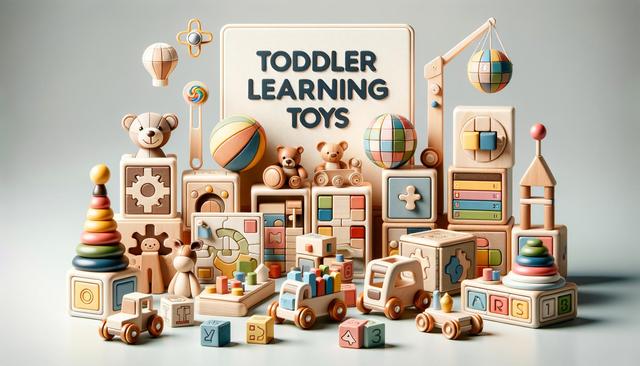
Encouraging Growth Through Play: A Guide to Toddler Learning Toys
Understanding the Role of Learning Toys in Early Childhood
During the toddler years, children experience rapid cognitive, emotional, and physical development. Learning toys support this growth by providing stimulating experiences that encourage exploration, problem-solving, and creativity. Unlike ordinary toys, learning toys are designed with a purpose, often targeting specific stages of development. These tools can range from simple stacking blocks to more complex interactive play sets that introduce early math or language skills.
What makes these toys particularly effective is how they align with a child’s natural curiosity. Toddlers are eager to touch, taste, and manipulate their environment. Well-designed learning toys take advantage of this by engaging multiple senses, promoting hands-on learning, and encouraging trial and error. This interaction not only entertains but also helps toddlers understand cause and effect, build fine motor skills, and develop early language and communication abilities.
Key Features to Look for in Toddler Learning Toys
When selecting learning toys for toddlers, it’s important to consider several key characteristics that contribute to their developmental value. Age appropriateness is the first factor—choosing toys that match a child’s developmental stage ensures they remain both safe and engaging. Additionally, look for toys that are open-ended, meaning they can be used in a variety of ways to support imaginative play and problem-solving.
Other important features include:
- Durability – Toys should withstand frequent use and the occasional drop or bite.
- Safety – Materials should be non-toxic, and designs should avoid small parts that pose choking hazards.
- Multi-sensory engagement – Toys that involve touch, sight, and sound enhance learning.
- Ease of use – Toddlers should be able to use the toy independently or with minimal assistance.
Parents and caregivers can also consider how a toy fits into a child’s specific interests. For example, a toddler who loves music might benefit from toys that introduce rhythm or sound patterns, while a child interested in movement may be better suited for toys that encourage stacking, sorting, or balancing activities.
Popular Types of Toddler Learning Toys
The market for toddler learning toys is broad, but certain categories consistently support essential developmental milestones. Understanding these types can help parents make informed choices. Among the most widely recognized learning toy types are:
- Stacking and nesting toys – These help develop fine motor skills and an understanding of spatial relationships.
- Shape sorters – Ideal for teaching color and shape recognition, as well as hand-eye coordination.
- Interactive books – Designed to promote early literacy skills and language comprehension.
- Building blocks – Encourage creativity, coordination, and early engineering concepts.
- Musical instruments – Support auditory development and rhythm recognition.
Each of these toy types offers unique benefits, and rotating between them can keep a toddler engaged while gradually building a wide range of skills. Additionally, many toys today incorporate simple technology, such as lights or sounds, that can further capture a toddler’s attention and reinforce learning.
How to Use Learning Toys Effectively at Home
Introducing learning toys is only the first step; how they’re used can greatly impact their effectiveness. One of the most valuable strategies is active participation. While toddlers benefit from independent play, including caregivers in the process—through guided interaction or simple observation—can enhance the learning experience.
Here are a few practical tips for maximizing the use of toddler learning toys at home:
- Create a dedicated play area free from distractions.
- Rotate toys regularly to maintain interest and introduce new challenges.
- Encourage open-ended play by asking questions like “What happens if…?”
- Celebrate small achievements to build confidence and motivation.
- Observe your toddler to identify which toys they gravitate toward and why.
Moreover, playing together provides opportunities to model behaviors, introduce new vocabulary, and reinforce positive social interactions. This shared time also strengthens the bond between child and caregiver, making learning both effective and emotionally rewarding.
Balancing Screen-Free and Tech-Enhanced Learning
As digital technology becomes more integrated into early childhood products, parents often wonder how to balance traditional toys with tech-based learning tools. While screen-free toys remain crucial for sensory development and imaginative play, tech-enhanced options can offer additional benefits when used appropriately.
For example, interactive toys that respond to a child’s actions with lights or sounds can reinforce cause and effect and keep toddlers engaged. However, it’s recommended to limit screen time and ensure that any digital interaction is age-appropriate and adult-supervised. Ideally, tech-based learning toys should complement—not replace—physical play and caregiver interaction.
Combining both types of toys can create a well-rounded environment that supports a toddler’s comprehensive development. Parents can start by introducing a few carefully selected tech-enhanced toys while continuing to prioritize hands-on activities such as building, drawing, or pretend play. This approach ensures that toddlers benefit from a diverse range of learning experiences.
Conclusion: Supporting Your Toddler’s Learning Journey
Toddler learning toys are more than just playful distractions—they are essential tools that lay the groundwork for lifelong learning. By choosing developmentally appropriate, engaging, and safe toys, caregivers can support their child’s physical, cognitive, and emotional growth. Whether it’s through stacking blocks, sorting shapes, or pressing buttons to hear a sound, each interaction helps build essential skills in a fun and nurturing way.
Parents and caregivers play a crucial role in guiding how these toys are used. Through thoughtful selection, active engagement, and balanced use of tech-enhanced and traditional options, toddlers can thrive in a playful learning environment that adapts to their evolving needs. Investing in learning toys is not just about keeping toddlers entertained—it’s about empowering them with the tools they need to explore, discover, and grow with confidence.